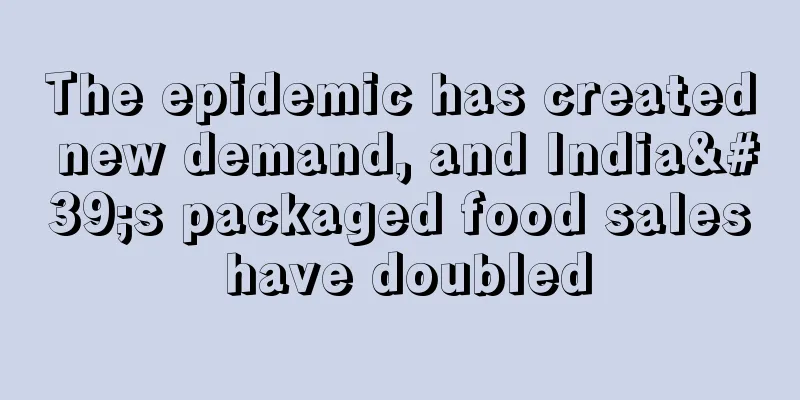The epidemic has created new demand, and India's packaged food sales have doubled

|
Before the outbreak of the epidemic, the mainstream food retail method in India was mainly bulk food. In the Kirana stores that are scattered throughout the streets and alleys of India , bulk biscuits, bulk noodles and various other bulk foods can be seen everywhere, but foods with modern packaging are hard to find.
Packaged foods cover a wide range. In addition to packaged biscuits, instant noodles, freeze-dried soup and other fast foods, packaged coffee, packaged tea and other tea drinks are also packaged foods. In addition, packaged foods also include packaged French fries, packaged potato chips, packaged dried fruits and other snacks and fruit products.
Compared with packaged food, Indian people prefer to buy loose food. However, it is impossible to determine important production information such as production date, raw materials, and origin of loose food. Moreover, without the protection of packaging, the food is more susceptible to moisture and deterioration. Therefore, loose food poses a huge safety hazard.
The Indian government has been trying to strengthen supervision of loose foods and promote the popularization of packaged foods in the country, but with little success. The epidemic has greatly changed this situation.
In 2020, the sales volume of packaged food in India increased significantly. The outbreak of the COVID-19 pandemic has made Indian people pay more attention to their health. Therefore, cleanliness and hygiene have become the topics that Indian people are most concerned about. As a result, the consumption patterns and habits of Indian people have changed greatly.
In terms of shopping methods, Indian people have begun to turn to online platforms to buy daily necessities and other products. In terms of payment methods, mobile payments have replaced cash payments. When it comes to food choices, Indian people pay more attention to safety, cleanliness and hygiene.
Under such circumstances, packaged foods that are clearly marked with production information and easy to store have become the first choice of the Indian people. At the same time, in order to curb the epidemic, the Indian government has also increased its supervision and publicity efforts. While strengthening supervision of loose foods, it also calls on people to buy packaged foods.
Driven by government calls and the impact of the epidemic, packaged food in India has finally ushered in spring, with sales increasing significantly. The trend of purchasing packaged food will continue, and the packaged food category will continue to grow. Cross-border e-commerce E-commerce market E-commerce platform |
>>: Sales increased by 160%! Canada Loblaw e-commerce is developing strongly
Recommend
What is Zhiou Technology? Zhiou Technology Review, Features
Zhiou Home Technology Co., Ltd. (Zhiou Technology...
What is Zero? Zero Review, Features
Zero Quit Smoking with a Plan That's Right for...
Often at the top of Amazon BS, traditional categories have a hot sale
Although the bicycle market is already a red ocea...
10,000 pieces of children's clothing were recalled and sold on multiple platforms
If you pay attention to the CPSC, you will find t...
A big seller revealed that he owed tens of millions in taxes?
After the honeymoon period, disputes between Dama...
What is Interson International Business Consulting Co., Ltd.? Interson International Business Consulting Co., Ltd. Review, Features
Intersun International Business Consulting Co., Lt...
Amazon's operational recruitment volume has dropped by 50%, but monthly salaries continue to rise!
Since July, Amazon's operations recruitment h...
Amazon Flex drivers strike to demand higher pay as oil prices soar
According to CNBC, on the morning of March 16, 20...
What is Fenmiao Network (openinstall)? Fenmiao Network (openinstall) Review, Features
openinstall is affiliated to Shenzhen Fenmiao Net...
What is Helian International Freight? Helian International Freight Review, Features
Helian International Freight (Zhejiang Helian Inte...
Summary of hot-selling products in Southeast Asia in 2021, electronic products become popular!
2021 is about to pass. In this year shrouded by t...
What is Wooshpay? Wooshpay Review, Features
Wooshpay is a one-stop payment platform that puts...
Taobao’s notice to online shoppers: If you watch CCTV Spring Festival Gala and browse Taobao, 40,000 shopping carts will be emptied!
This year, Taobao will be on CCTV Spring Festival...
95% of people over 55 shop online regularly, and middle-aged and elderly people have become the main force of e-commerce growth
According to a new study , 95 % of people over 55...
Shenzhen VAT service provider ran away, thousands of tax numbers were affected!
As the end of the year approaches, it is a time o...









